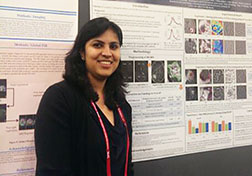
NEW YORK - A computer programme developed by a team of researchers led by an Indian-origin scientist has outperformed physicians in diagnosing brain cancer. The programme was nearly twice as accurate as two neuroradiologists in determining whether abnormal tissue seen on magnetic resonance images (MRI) were dead brain cells caused by radiation, called radiation necrosis, or if brain cancer had returned,

reported a study published online in the American Journal of Neuroradiology on Thursday. "One of the biggest challenges with the evaluation of brain tumour treatment is distinguishing between the confounding effects of radiation and cancer recurrence," said Pallavi Tiwari, Assistant Professor at Case Western Reserve University in Cleveland, Ohio. "On an MRI, they look very similar," she said.
With further confirmation of its accuracy, radiologists using their expertise and the program may eliminate unnecessary and costly biopsies Tiwari said.
Brain biopsies are currently the only definitive test but are highly invasive and risky, causing considerable morbidity and mortality.
To develop the programme, the researchers employed machine learning algorithms in conjunction with radiomics, the term used for features extracted from images using computer algorithms. The team trained the computer to identify radiomic features that discriminate between brain cancer and radiation necrosis, using routine follow-up MRI scans from 43 patients. The team then developed algorithms to find the most discriminating radiomic features, in this case, textures that cannot be seen by simply eyeballing the images.
"What the algorithms see that the radiologists don't are the subtle differences in quantitative measurements of tumour heterogeneity and breakdown in microarchitecture on MRI, which are higher for tumour recurrence," Tiwari said.
In the direct comparison, two physicians and the computer programmes analysed MRI scans from 15 patients from University of Texas Southwest Medical Center. One neuroradiologist diagnosed seven patients correctly, and the second physician correctly diagnosed eight patients. The computer program was correct on 12 of the 15, the study said.
With further confirmation of its accuracy, radiologists using their expertise and the program may eliminate unnecessary and costly biopsies Tiwari said.
Brain biopsies are currently the only definitive test but are highly invasive and risky, causing considerable morbidity and mortality.
To develop the programme, the researchers employed machine learning algorithms in conjunction with radiomics, the term used for features extracted from images using computer algorithms. The team trained the computer to identify radiomic features that discriminate between brain cancer and radiation necrosis, using routine follow-up MRI scans from 43 patients. The team then developed algorithms to find the most discriminating radiomic features, in this case, textures that cannot be seen by simply eyeballing the images.
"What the algorithms see that the radiologists don't are the subtle differences in quantitative measurements of tumour heterogeneity and breakdown in microarchitecture on MRI, which are higher for tumour recurrence," Tiwari said.
In the direct comparison, two physicians and the computer programmes analysed MRI scans from 15 patients from University of Texas Southwest Medical Center. One neuroradiologist diagnosed seven patients correctly, and the second physician correctly diagnosed eight patients. The computer program was correct on 12 of the 15, the study said.

 RSS Feed
RSS Feed
